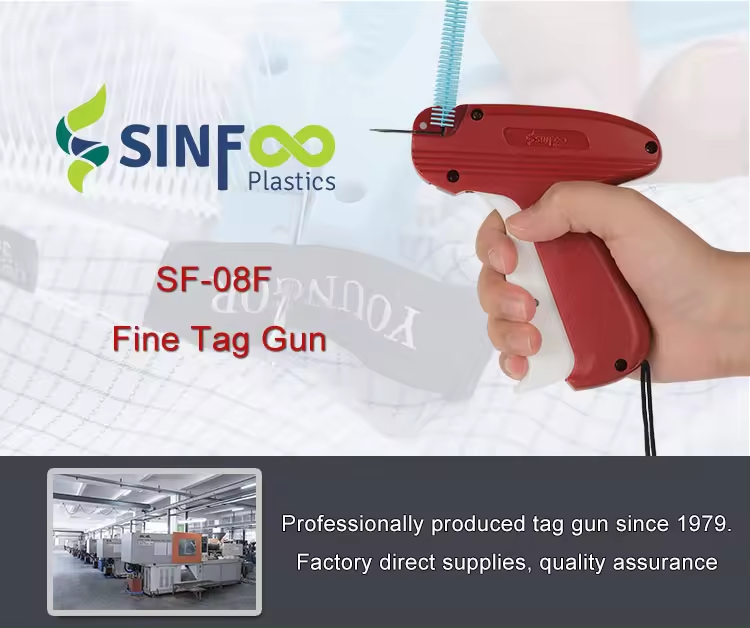From Novice to Pro: Choosing the Right Tag Gun Needles for Your Clothing Business

Understanding Tag Guns and Their Importance in Clothing Retail
What Is a Tag Gun?
A tag gun is a tool used in the clothing industry. It quickly attaches price tags to garments. With this device, one can tag a large number of items fast and with ease. It has a needle that pushes through the fabric. Then, it inserts a small plastic fastener to secure the tag. This method is much quicker than hand-sewing or pinning. Tag guns are key for shops that need to tag lots of items, like in retail. They save time and make sure tags stay in place on clothes. This is good for both tracking inventory and for sales.
How Tag Guns Can Improve Efficiency in Your Business
Tag guns are a big help in clothing shops. They make pricing and tagging clothes quick and smooth. With a tag gun, you can do the work of several people. This means you save time and money. Also, using a tag gun is easy to learn. This makes training new staff simpler. Tag guns ensure price tags stay on clothes. This keeps displays neat and tidy. It also avoids lost tags, which can cause cash register delays. With a tag gun, your shop will run better and look more pro. It's a small tool, but it can have a big impact on your business's success.
The Different Types of Tag Guns Available
In the retail clothing world, there are various types of tag guns to choose from. Here's a simple list:
- Standard Piston Tag Guns: Ideal for thicker fabrics.
- Fine Fabric Tag Guns: Best for delicate materials.
- Long-needle Tag Guns: Suited for items with thick seams.
- Pneumatic Tag Guns: They use air pressure, perfect for high volume tagging.
Choose the one that fits the materials and volume of your business.
Selecting the Right Tag Gun Needles for Your Needs
Factors to Consider When Choosing Tag Gun Needles
- Material and Durability: Look for needles made of durable materials. They must resist bending or breaking.
- Size and Thickness: Choose the right size for your fabric. Thicker needles are for heavier materials.
- Type of Clothing: Delicate fabrics need finer needles. This prevents damage to the garments.
- Brand Compatibility: Make sure the needles fit your tag gun model. Not all needles work with every gun.
- Quantity and Cost: Buy in bulk to save money if you tag often. Yet, don't compromise on quality.
- Ease of Replacement: Pick needles that are easy to change. This keeps work flowing smoothly.
The Compatibility Between Tag Guns and Needles
When choosing tag gun needles, it’s vital to ensure they match your gun. Different tag guns may require specific needle types, which could affect the tagging process. Some tag guns are designed to only work with proprietary needles, while others can accommodate universal types. Always check the model of your plastic tag gun for clothing to find compatible needles. Using the wrong needles can lead to malfunctions, damage to the gun, or even injury during use. To make the best choice, consult the manufacturer's guide or ask an expert.
Maintaining Your Tag Gun Needles
To keep your plastic tag gun for clothing in top shape, regular maintenance is key. Here’s how to care for your tag gun needles effectively:
- Regular Inspection: Before each use, check needles for signs of bending, dullness, or damage. Replace them if needed.
- Proper Handling: Always handle needles with care. Avoid dropping or placing heavy items on the gun to prevent bending the needles.
- Keep it Clean: After use, clean the gun and needles to remove any fabric fibers or debris. This prevents clogging and ensures smooth operation.
- Safe Storage: Store tag gun needles in a secure container or holder when not in use to protect them from getting damaged.
By doing these simple steps, you’ll extend the life of your tag gun needles and ensure tagging efficiency.
Best Practices for Using Plastic Tag Guns in Clothing Businesses
Step-by-Step Guide on How to Use a Tag Gun
- Lay the garment flat and smooth out any wrinkles where you will attach the tag.
- Insert the correct needle into the tag gun, ensuring it locks into place securely.
- Load the fasteners into the gun according to the manufacturer's instructions.
- Position the tag on the garment at the desired location, usually on a seam or brand label.
- Hold the gun perpendicular to the fabric to ensure a straight insertion.
- Squeeze the trigger firmly to insert the fastener and attach the tag.
- Gently pull the gun away, making sure the tag is secure and the fastener is not bent.
- Check that the tag is fastened properly without damaging the fabric.
- Repeat the process for the remaining items, maintaining a consistent tagging approach.
- Regularly check the needle for any signs of dullness and replace as necessary.
Common Mistakes to Avoid When Tagging Clothing
- Do not use dull or bent needles; they can damage clothing.
- Avoid tagging on delicate fabrics at stress points, like where seams meet.
- Make sure the tag gun is properly loaded to prevent misfiring.
- Hold the gun perpendicular to the garment to ensure a clean insert.
- Don't force the gun if tagging feels tough; this can cause rips.
- Check the needle is right for your tag gun to prevent jams.
- Never rush tagging; accidents are more likely when you hurry.
- Regularly clean your tag gun to keep it in good working order.
Tips for Efficient and Safe Use of Tag Guns
Using plastic tag guns efficiently and safely boosts productivity while reducing the risk of damaging garments. To achieve this, follow these simple tips:
- Read the Manual: Before use, always read the manual. It helps you understand your tag gun’s features.
- Test on Scrap Fabric: Practice tagging on scrap fabric to get a feel for the needle and how much pressure to apply.
- Use the Right Needle: Make sure you have the correct needle for your fabric. Thicker fabrics may require a stronger needle.
- Tag on Seams: Place tags on seams or labels to avoid holes in the main areas of the clothing.
- Keep it Clean: Regularly clean your tag gun to prevent jamming. A clean gun is a smooth-operating gun.
- Store Safely: When not in use, store the gun with a safety cap to protect the needle and users.
- Regular Inspections: Check your tag gun and needles for dullness or damage to ensure they’re always ready for use.
By following these guidelines, you’ll tag clothes quickly, neatly, and without harm to the items or yourself.
Relatd article:



